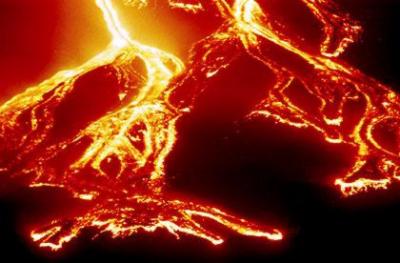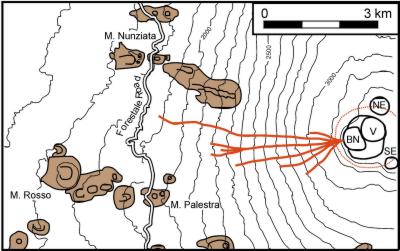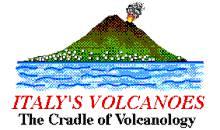
Dramatic
shot (taken by press photographer Fabrizio Villa) of lava flows spilling
down the W flank of Etna during the night of 17-18 October. This view
is from the area near Monte Palestra, located at about 1900 m on the
W flank of the volcano.

Sketch
map of the upper W flank and the summit area of Etna, showing the
approximate directions of lava flows coming from the Bocca Nuvoa as
of 19 October, 2000 h. The true extent of the new lava will be shown
in a future map. Dotted line around the summit craters encircles area
subjected to heavy falls of large bombs from explosive activity within
the Bocca Nuova.
|
WARNING:
Access to the summit craters is EXTREMELY
DANGEROUS. Activity in the Bocca Nuova and the Voragine
is very intense, and bombs are falling over all of the summit
area. Access to the craters themselves is absolutely impossible.
Besides this, weather conditions are often unstable, even during
the summer; summit visitors may be surprised by snowstorms (as
occurred on 24 July 1999) or thunderstorms: one man was killed
by lightning at about 2000 m elevation near Piano Provenzana
on 30 August. Any person who enters the area beyond the Torre
del Filosofo mountain hut (2900 m elevation) or the hut of the
guides on the northern flank (Baita delle guide, 3000 m elevation)
goes at his/her own risk and is not covered by any insurance
in case a rescue operation (e.g., with helicopters) is necessary.
|
21
October 1999 update.
After continuing vigorously until the early morning of 20 October,
the activity from the eruptive vents in the W and NW part of the Bocca
Nuova ceased, and the overflow of lava through the notch (formed on
17 October) in the W crater rim stopped. Sometime around dawn (0700
h local time=GMT+2), forceful expulsions of ash began from the SE
vent in the Bocca Nuova, which had shown little activity in the past
week. Later that day weather conditions deteriorated, and visual observations
were rendered impossible. However, it was stated this morning that
the activity was at low levels throughout the day (communication from
Marco Fulle, Osservatorio Astronomico di Trieste, who presently stays
at the Rifugio Sapienza and received this information from forest
guard personnel). This morning at 0300 h, intense eruptive activity
reportedly resumed, with renewed lava overflow from the Bocca Nuova
onto the W flank. As of the early afternoon of 21 October, bad weather
is preventing visual observations.
20
October 1999 update.
During the past ten days or so, vigorous episodic activity within
the Bocca Nuova gradually filled the crater (its depth was about 30
m below the lowest point of the crater rim, on the W side, when observed
on 1 October), and on the late evening of 17 October, a section of
the W crater rim about 25 m wide collapsed, and lava rapidly spilled
through the newly formed breach onto the W flank of the main summit
cone, covered the dirt road which connects the northern and southern
ascent routes over a width of several tens of meters, and then flowed
down the W flank of Etna in at least four main branches. By the early
morning of 18 October, the farthest flow front was at about 2000 m
elevation, in an area located roughly between Monte Nunziata and Monte
Palestra, just above the tree line, and only a few hundred meters
from the Forest Guard road (Forestale road).
At the time of the overflow, spectacular lava fountaining occurred
from two main vents located in the W and NW part of the crater. This
activity apparently diminished during the late forenoon of 18 October,
but resumed during the following night. Lava was reported to flow
vigorously through the newly formed breach on the W side of the Bocca
Nuova on the evening of 18 October (oral information from the mountain
guides at Piano Provenzana on the N flank of Etna).
At about noon on 19 October, Boris Behncke (Dipartimento di Scienze
Geologiche, University of Catania) and Giuseppe Scarpinati (Italian
correspondent of the French Association Volcanologique Européenne)
reached the western side of the summit area, coming from Piano Provenzana
with some of the mountain guides. At the time of their arrival near-continuous
explosive activity ejected large bombs high above the rim of the Bocca
Nuova (many bombs fell far beyond the crater rim), but movement of
the lava flow had slowed significantly, and only the central portion
of the flow moved at a speed of no more than 10 cm per minute. The
flow overflowed from the crater through a deep channel; below this
the lava field emplaced since late 17 October widened, with many overlapping
and adjacent flow units which had a total width of about 100 m at
the interrupted summit dirt road. Between 1200 and 1230 h (local time=GMT+2)
the activity of the Bocca Nuova increased significantly, until fountaining
from the more southerly of the two vents became virtually continuous,
and frequent large blasts occurred from the other vent, dropping bombs
up to 150 m beyond the crater rim.
A short time later, the rate of lava overflowing into the channel
below the Bocca Nuova rim increased dramatically, and a new flow with
a front about 3 m high advanced rapidly through the central flow channel,
on top of the still-moving, earlier lava. At the elevation of the
interrupted dirt road the flow front was seen to advance about 100
m in 5 minutes; below this elevation the flow split into several branches
and slowed, but when arriving at the steep W slope of Etna, movement
of the flow fronts became much faster again. Among the notable features
of this newly advancing lava was the little sound it made, probably
due to its high fluidity.
Behncke and Scarpinati observed the activity until about 1500 h; during
this period lava fountaining continued with some fluctuations, and
several particularly powerful explosions from the more northerly vent
sent bombs to as far as the central part of the adjacent Voragine.
From certain points along the N margin of the new lava field the summit
of a sizeable pyroclastic cone growing within the Bocca Nuova could
be seen rising high above the crater rim. Occasionally large glowing
blocks of lava appeared on the crater rim to the S of the overflow
channel and tumbled down the SW side of the main summit cone. It is
probable that the level of lava filling the crater was almost as high
as the rim on this side, and the continuous addition of lava caused
its margins to extend over the lower parts of the crater rim, although
no true overflow occurred besides the one on the W side.
After returning to Piano Provenzana in the mid-afternoon, Behncke
and Scarpinati drove towards Bronte on the lower W flank of Etna;
while driving towards this town it was noted that explosive activity
at the Bocca Nuova had apparently diminished, and only a few ash-rich
emissions occurred between 1630 and 1730 h. Flowing lava was distinctly
visible on the W flank, the fronts of the new lava flows initiated
at about 1230 h had extended about half way down the steep W flank
of Etna and were at about 2400-2500 m elevation; the flows emplaced
during the previous day were stagnating. Behncke and Scarpinati climbed
the cone of Monte Ruvolo, an old flank crater on the W flank of Etna,
about 7 km from the summit, from where they had a spectacular view
of the scene of the current activity. After sunset (about 1830 h),
the active flows were brightly incandescent over all of their length,
and the activity of the Bocca Nuova increased again, producing awesome
bursts of huge incandescent bombs every 2-10 seconds. Bombs were sprayed
over most of the summit area, arriving even at the summit of the Northeast
Crater. As before, two vents were erupting within the Bocca Nuova.
As time passed, the lava fronts on the W slope of Etna slowed, but
two new branches of lava began to descend from below the Bocca Nuova,
one following in the central part of the new lava flow-field, the
other much further to the south, and by 2030, these branches began
to spill down the steep W flank. Near continous powerful bursts of
huge bombs continued by 2100 when Behncke and Scarpinati drove back
to Catania.
This new phase of activity is very similar to a phase of the 1964
eruption when lava overflowed from the Central Crater (now replaced
by the two craters Voragine and Bocca Nuova) onto the W flank of Etna,
following essentially the same path as the new lava, and later lava
broke through the SSW crater rim and spilled down the flank of the
main summit cone, forming a 4 km-long flow on the SSW flank which
narrowly missed the building of the former Etna Observatory (this
was eventually destroyed by an eruption in 1971). The activity in
the past ten days or so is clearly episodic, and the overflow of lava
from the Bocca Nuova is not continous, but rather consists of surges
which last several hours, emplacing numerous flow units on top and
aside each other. For this reason it is unlikely that any lava on
the W flank will proceed much further than the farthest flow fronts
of 17/18 October, and the only risk is that the lava will destroy
some forest, bury a portion of the Forestale road and endanger a mountain
hut near Monte Palestra.
On the other hand, it is extremely dangerous to get close to the summit
area, especially during phases of violent Strombolian activity as
observed during the evening of 19 October. This activity is launching
thousands of meter-sized bombs to places such as the Northeast and
Southeast Craters, and any person who desires to see the ongoing activity
should consult the local mountain guides at the Rifugio Sapienza (or
the cable car station) on the S flank of Etna or those at Piano Provenzana
on the N flank. The former can be reached by car from Nicolosi while
the latter is best reached from Linguaglossa (driving uphill on the
"Mareneve" road). A spectacular view of the eruption and
the lava flowing down the W flank can be obtained from Bronte - there
is a small country road leading from this town about 5 km further
upslope to a gate at the margin of the inner zone of the Etna Natural
Park, where in these days numerous spectators assemble to witness
the unique natural display. Lava flows on that side of the mountain
were last seen in 1964 and during a small flank eruption in 1974.
If the eruption follows the same pattern as the 1964 activity, then
the activity may last for weeks to months, with further overflows
of lava from the summit craters.
To
learn more about the 1964 eruption, visit
this page.

visitors counted since 12 February 1999
(more than 10,000 during the first 3 weeks!)
FastCounter
by LinkExchange
Page set up on 27 May 1997, last modified
on 21 October 1999


